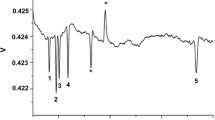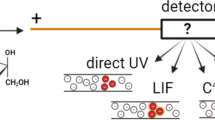Abstract
During the production of bio-based bulk chemicals, such as lactic acid (LA), organic impurities have to be removed to produce a ready-to-market product. A capillary electrophoresis method for the simultaneous detection of LA and organic impurities in less than 10 min was developed. LA and organic impurities were detected using a direct UV detection method with micellar background electrolyte, which consisted of borate and sodium dodecyl sulfate. We investigated the effects of electrolyte composition and temperature on the speed, sensitivity, and robustness of the separation. A few validation parameters, such as linearity, limit of detection, and internal and external standards, were evaluated under optimized conditions. The method was applied for the detection of LA and organic impurities, including tyrosine, phenylalanine, and pyroglutamic acid, in samples from a continuous LA fermentation process from post-extraction tapioca starch and yeast extract.



Similar content being viewed by others
Abbreviations
- LA:
-
Lactic acid
- LAB:
-
Lactic acid bacteria
- PGA:
-
Pyroglutamic acid
- Phe:
-
Phenylalanine
- Trp:
-
Tryptophan
- Tyr:
-
Tyrosine
- CZE:
-
Capillary zone electrophoresis
- EOF:
-
Electroosmotic flow
- LOD:
-
Limit of determination
- LOQ:
-
Limit of quantitation
References
Werpy T, Petersen G, Top value added chemicals from biomass: volume 1: results of screening for potential candidates from sugars and synthesis gas. https://www.osti.gov/scitech/biblio/15008859%5D
Vink ETH, Davies S, Kolstad JJ (2010) Original research: the eco-profile for current Ingeo® polylactide production. Ind Biotechnol 6:212–224
Norwood DL, Qiu F, Mullis JO (2006) Trace level impurity analysis, pp 3797–3813. Encyclopedia of Pharmaceutical Technology, Third Edition. Informa Healthcare, Zug
Laube H, Reza MT (2016) Application of biosorbents for ion removal from sodium lactate fermentation broth. J Environ Chem Eng 4:10–19
Laube H, Matysik F-M, Schmidberger A, Mehlmann K, Toursel A, Boden J (2016) CE-UV/VIS and CE–MS for monitoring organic impurities during the downstream processing of fermentative-produced lactic acid from second-generation renewable feedstocks. J Biol Eng 10:1–11
Romano JJP, Jones WR, Jackson PE (1991) Optimization of inorganic capillary electrophoresis for the analysis of anionic solutes in real samples. J Chromatogr 546:10
Kenney BF (1991) Determination of organic acids in food samples by capillary electrophoresis. J Chromatogr A 546:423–430
Jones WR, Jandik P (1992) Various approaches to analysis of difficult sample matrices of anions using capillary ion electrophoresis. J Chromatogr A 608:385–393
Klampfl CW, Buchberger W, Haddad PR (2000) Determination of organic acids in food samples by capillary zone electrophoresis. J Chromatogr A 881:357–364
Galli V, García A, Saavedra L, Barbas C (2003) Capillary electrophoresis for short-chain organic acids and inorganic anions in different samples. Electrophoresis 24:1951–1981
Lagoutte D, Lombard G, Nisseron S, Papet MP, Saint-Jalm Y (1994) Determination of organic acids in cigarette smoke by high-performance liquid chromatography and capillary electrophoresis. J Chromatogr A 684:251–257
Mainka A, Ebert P, Kibler M, Prokop T, Tenberken B, Bächmann K (1997) Development of new methods for the analysis of carboxylic acids and carbonyl compounds in size classified raindrops by CE for application in modelling atmospheric processes. Chromatographia 45:158–162
Volgger D, Zemann AJ, Bonn GK, Antal MJ (1997) High-speed separation of carboxylic acids by co-electroosmotic capillary electrophoresis with direct and indirect UV detection. J Chromatogr A 758:263–276
Sharman DC (1997) Determination of lactic acid and poly(lactic acid)s in a dermatological formulation by capillary electrophoresis. Analyst 122:709–713
Schober TJ, Bean SR, Wang D (2009) Capillary electrophoresis as a tool for evaluating lactic acid production from sorghum. Cereal Chem 86:117–121
Pérez-Míguez R, Marina ML, Castro-Puyana M (2016) Capillary electrophoresis determination of non-protein amino acids as quality markers in foods. J Chromatogr A 1428:97–114
Poinsot V, Ong-Meang V, Gavard P, Couderc F (2016) Recent advances in amino acid analysis by capillary electromigration methods, 2013–2015. Electrophoresis 37:142–161
Acunha T, Ibáñez C, García-Cañas V, Simó C, Cifuentes A (2016) Recent advances in the application of capillary electromigration methods for food analysis and Foodomics. Electrophoresis 37:111–141
Laube H, Schneider R, Venus J (2017) Investigation of spiral-wound membrane modules for the cross-flow nanofiltration of fermentation broth obtained from a pilot plant fermentation reactor for the continuous production of lactic acid. Bioresour Bioprocess 4:4
EMEA, ICH Topic Q 2 (R1): Validation of Analytical Procedures: Text and Methodology. http://webcache.googleusercontent.com/search?q=cache:BBNJCeEQY-kJ:www.ema.europa.eu/docs/en_GB/document_library/Scientific_guideline/2009/09/WC500002662.pdf+&cd=1&hl=de&ct=clnk&gl=de&client=safa
Acknowledgements
The authors would like to thank the Department of Bioengineering at the Leibniz-Institute for Agricultural Engineering (ATB) for the provision of sample material from the SynRg research project and the Fachagentur Nachwachsende Rohstoffe e.V. (FNR)/Bundesministerium für Landwirtschaft, Ernährung und Verbraucherschutz (BMELV) for funding the SynRg (22023008) research project and the American Journal Experts (AJE) for language editing and manuscript revision. This research is supported by funds from the Bioenergy 2020 program allocated from the German Federal Ministry of Research and Education to Project Management Jülich (PtJ). The analytical part was supported by ICA, a company for chemical analysis located in Langen (Germany).
Author information
Authors and Affiliations
Corresponding author
Ethics declarations
Conflict of interest
The authors declare that they have no competing interests.
Authors’ contributions
HL designed and coordinated the study, performed the data analysis, and drafted the manuscript. JB performed the analysis on the CE-UV/Vis system and helped draft the manuscript. RS carried out the fermentation procedure. All authors read and approved the final manuscript.
Electronic supplementary material
Below is the link to the electronic supplementary material.
Rights and permissions
About this article
Cite this article
Laube, H., Boden, J. & Schneider, R. Capillary electrophoresis method for the analysis of organic acids and amino acids in the presence of strongly alternating concentrations of aqueous lactic acid. Bioprocess Biosyst Eng 40, 981–988 (2017). https://doi.org/10.1007/s00449-017-1761-7
Received:
Accepted:
Published:
Issue Date:
DOI: https://doi.org/10.1007/s00449-017-1761-7




